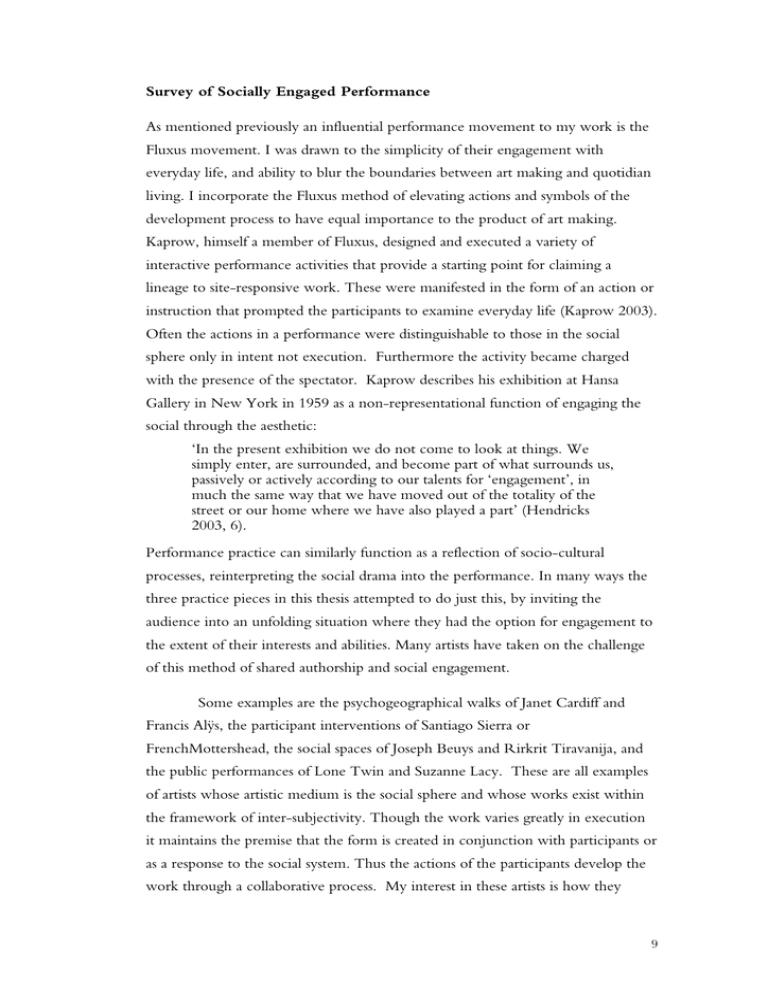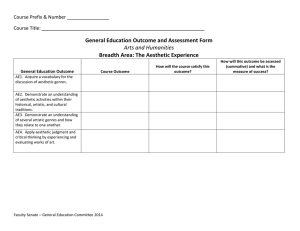Survey of Socially Engaged Performance As mentioned previously
advertisement

Survey of Socially Engaged Performance As mentioned previously an influential performance movement to my work is the Fluxus movement. I was drawn to the simplicity of their engagement with everyday life, and ability to blur the boundaries between art making and quotidian living. I incorporate the Fluxus method of elevating actions and symbols of the development process to have equal importance to the product of art making. Kaprow, himself a member of Fluxus, designed and executed a variety of interactive performance activities that provide a starting point for claiming a lineage to site-responsive work. These were manifested in the form of an action or instruction that prompted the participants to examine everyday life (Kaprow 2003). Often the actions in a performance were distinguishable to those in the social sphere only in intent not execution. Furthermore the activity became charged with the presence of the spectator. Kaprow describes his exhibition at Hansa Gallery in New York in 1959 as a non-representational function of engaging the social through the aesthetic: ‘In the present exhibition we do not come to look at things. We simply enter, are surrounded, and become part of what surrounds us, passively or actively according to our talents for ‘engagement’, in much the same way that we have moved out of the totality of the street or our home where we have also played a part’ (Hendricks 2003, 6). Performance practice can similarly function as a reflection of socio-cultural processes, reinterpreting the social drama into the performance. In many ways the three practice pieces in this thesis attempted to do just this, by inviting the audience into an unfolding situation where they had the option for engagement to the extent of their interests and abilities. Many artists have taken on the challenge of this method of shared authorship and social engagement. Some examples are the psychogeographical walks of Janet Cardiff and Francis Alÿs, the participant interventions of Santiago Sierra or FrenchMottershead, the social spaces of Joseph Beuys and Rirkrit Tiravanija, and the public performances of Lone Twin and Suzanne Lacy. These are all examples of artists whose artistic medium is the social sphere and whose works exist within the framework of inter-subjectivity. Though the work varies greatly in execution it maintains the premise that the form is created in conjunction with participants or as a response to the social system. Thus the actions of the participants develop the work through a collaborative process. My interest in these artists is how they 9 develop this collaborative model and execute its methods. In this section I will focus on FrenchMottershead, Francis Alÿs and Lone Twin in order to give a brief overview of the modes social of engagement in site responsive practice. I begin with Rebecca French and Andrew Mottershead from the group FrenchMottershead, as a good example of artists utilising the social sphere as an artistic medium. Developing socially engaged work since 1999, they have a broad array of experiments that intervene in the social system. Their work often presents the simplicity of human interactions in a devised format. According to Rebecca and Andrew in an interview I held with them in April of 2010, they have termed this format a ‘microperformance’. These microperformances take on the form of Boalian invisible theatre with a mix of participants and spectators that become blurred as they are given simple instructions for interaction. Unlike the Boal technique, all participants in a given event are aware that it is a combination of staged happening mixed with everyday socialising. One example is their People Series, where social interactions are intervened through a series of gestural commands.iii In the performance, instructions on a simple card are passed to participants and request such things as lie to impress or insist others pass through a doorway first. These instructions create small interceptions in time that can easily be mistaken for the quotidian. The revelation that the microperformances create is that the spectator/participant cannot distinguish fact from fiction, reality from performance. A melding of the social and aesthetic drama that plays with intent by merging into the performance of everyday life. The simplicity of this project speaks of its success and ability to be recreated in a variety of social venues from a gallery to a workingmen’s club. Joshua Sofaer describes his experience of attending the microperformance Friday Social Evening, developed in collaboration with WestIndian Ex-Services Association, as a ‘live action version that put you in the thick of this faction quagmire and forced you to be partisan and participant. There was a continual oscillation between belief and suspicion, between enjoyment in your disbelief and irritation and your inability to accept something as either genuine or a lie.’iv This refers back to Kaprow and his acknowledgement that the work is an invitation to the audience to be as active or as passive as is in their interest and capability for engagement. The work is present; the reception is up to the viewer. From this perspective I have chosen to focus on the devising and developing of the 10 work instead of audience reception and perception both in this section and throughout the thesis. FrenchMottershead are an interesting example in that they intervene in a social system without the intention to socially ameliorate. According to FrenchMottershead, they are interested in methods with which performance can be inserted into everyday life, as opposed to everyday life being a source for performance practice. This is an attempt to blur the boundaries between fact and fiction, as the audience member cannot distinguish the actions of a performing individual executing a simple repetitive gesture with another audience member who may be attending the event. In the work Shops FrenchMottershead researched the inter-subjectivities between shopkeepers and their clientele (FrenchMottershead 2010). They travelled to various locations around the world collaborating with chosen shops in order to understand how the shop impacted the surrounding locale and the interactions with their customer base. Carol Maund, director of Site Gallery who sponsored the two-year expedition describes how ‘FrenchMottershead worked together with different communities showing the possibilities of local difference amidst the dominant, highly commodified world of shops and shopping’ (Ibid, 8). To create the work an invitation was extended to customers to attend a specific date and time for a photo shoot of them in front of the shop. Those who came ended up participating in an inter-subjective performance encounter that was captured and archived through photography. This ‘photo event’, as was described to me by FrenchMottershead, is not only an archive but also a celebration of the site and its participants. In essence the framing of the event, of the inter-subjective moment and the interrelationships existing in a small business, create the work of art. The work is created in response to how the surrounding community utilises the site, which situates the context as key to the content. When I asked about participants’ reaction to the work, Andrew stated that often ‘they never thought of their lives in this way, of these various social formations, and when something is represented like that you can analyse it and begin to maybe make connections and understand the system you are part of a little better’. Writer and critic Emma Cocker terms the intricacies of a social system through an aesthetic lens as ‘social assemblage’ (Ibid, 152). According to Cocker, FrenchMottershead ‘attend to the individual performances of identity and social ritual within different contexts in order to reveal their grammatical coding, 11 the behavioural etiquette operating therein. … these various social conventions … become used as raw material through which to create new forms of expression and exchange’ (Ibid, 153). This notion of social conventions as material with which to create work is what locates the practice of FrenchMottershead, though varied in its execution, into this survey of socially engaged practice. Another performance duo whose live actions are centred on community and society are Brighton-based Lone Twin. Through their public projects they claim to ‘create community-based projects and performances for specific sites and locations’ which they do through a variety of formats.v One of the most concise examples of utilizing the public sphere as an artistic medium and place of engagement is their project Speeches.vi In this work members of the public were asked to collaborate with the development of the work by offering their own biographies as a performative gesture. Participants worked with a professional speechwriter in order to retell their site-responsive stories at a chosen locale, through a speech. Speeches was first presented throughout the Barbican estate over a week in mid-September of 2008.vii The audience was guided to each location where an innocuous passer-by stood on a soapbox-like structure and delivered their prewritten speech. During my visit, some arrived by foot, some were already awaiting our arrival. One of the performers, a courier, arrived rushing on his bicycle two minutes late and gave his speech slightly out of breath. This was a break in their schedules to offer us a slice of life, a reality re-presented for a brief moment as performance. The success of the work lay in its ability to take the mundane and heighten it through its representation as a performance encounter. The collaborative performance work of Francis Alÿs utilises a similar method of interaction with participants to create an inter-subjective artistic moment. According to Alÿs collaboration ‘is about letting the original scenario go, letting it be translated by others and bounced back and forth. If the story is good enough, it will get back to you or achieve its shape by itself’ (Medina, Ferguson and Fisher 2007, 16). Alÿs structures his work conceptually into three phases: preparatory, event, and re-presentation. The preparatory phase relates closely to this practice-led research as it begins with the initial impetus of the artist to develop an aesthetic that integrates itself as an action in the social sphere (Ibid, 108-110). This notion of agency and communion are closely affiliated with my practical research interests. In 2002 Alÿs created Cuando La Fé Mueve Montañas (When Faith Moves Mountains) completed in collaboration with Rafael Ortega 12




